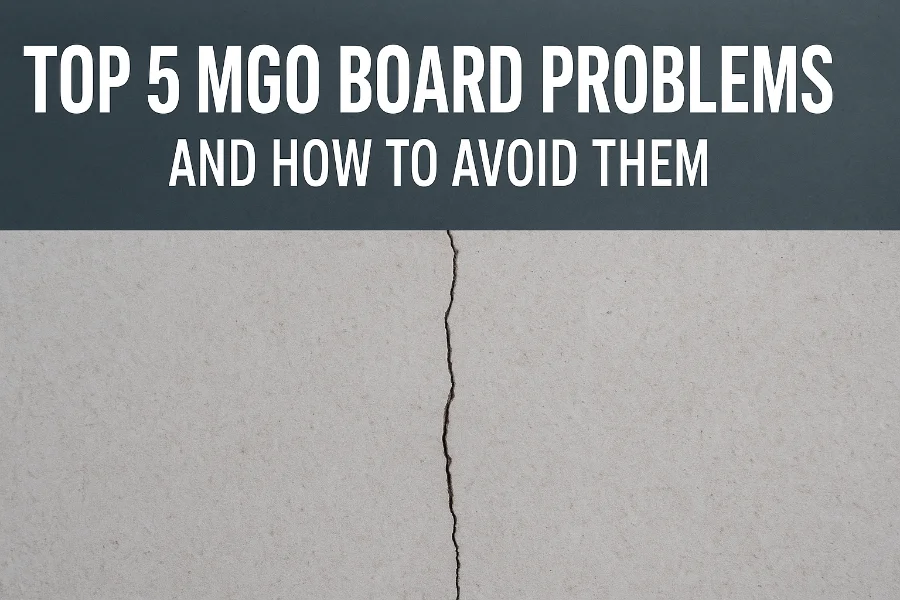Table of Contents
Introduction
As magnesium oxide board (often referred to as MgO board) gains global attention as a fire-resistant, sustainable building material, a persistent question arises online: “Is magnesium oxide board banned?” Some blogs, forums, and regional news sources have contributed to confusion and speculation, leading contractors, architects, and homeowners to hesitate.
This article clears up misconceptions by examining the facts behind these rumors. We’ll explore:
- Why some people think MgO boards are banned
- Countries with specific restrictions
- The science behind MgO board performance
- Regulatory compliance in major regions like the US, EU, UK, Australia, and the Middle East
- When and where to use MgO board safely and effectively
What Is Magnesium Oxide Board?
Magnesium oxide board is a non-combustible sheathing material made primarily from magnesium oxide (MgO), magnesium sulfate (MgSO4) or magnesium chloride (MgCl2), perlite, wood fiber, and fiberglass mesh. It is often used as:
- Wall and ceiling lining
- Subflooring
- Exterior sheathing
- Tile backer board
Key benefits include:
- Fire resistance (Class A / non-combustible)
- Mold and moisture resistance
- No toxic smoke release
- High strength-to-weight ratio
Because of its performance, MgO boards are used in modular construction, commercial buildings, and increasingly in residential applications.
Why Do People Think MgO Board Is Banned?
There is no global ban on magnesium oxide board. However, certain issues in cold or humid climates—particularly in northern Europe—have led to confusion.
The Denmark Case
The origin of the “MgO board ban” myth stems largely from Denmark, where some MgO boards (commonly known as “hygroscopic boards”) installed in the early 2010s led to moisture-related issues:
- Boards absorbed water from humid air due to high magnesium chloride (MgCl₂) content
- This led to corrosion of metal parts and electrical damage
As a result, Denmark’s Building Research Institute recommended against the use of specific MgO boards as external wind barriers—but did not outlaw all MgO boards.
The Real Problem: Untreated Chloride Ions
In many of these problematic cases, the MgO boards were manufactured with magnesium chloride as a binder, but without proper treatment of excess chloride ions. Some producers, in an effort to reduce costs, skipped essential soaking processes during production. This resulted in boards that absorbed moisture and released chloride salts over time—a phenomenon known as “crying boards” or salt leaching.
This leaching led to corrosion of screws, fasteners, and embedded steel components, especially in cold or humid climates. It is important to note that:
- These issues occurred only in low-quality, untreated MgCl₂-based boards
- Magnesium sulfate (MgSO₄) boards, also known as “sulfate-based boards,” do not have this issue and have not been involved in bans or restrictions
Is Magnesium Oxide Board Banned in the US or UK?
No. In both the United States and United Kingdom, MgO boards are not banned. In fact:
- MgO boards can be found in UL-listed fire-rated assemblies in the U.S.
- ASTM E84 and ASTM C1177 standards apply for fire and mold performance
- In the UK, MgO boards are used in light steel frame construction and meet BS EN 13501-1 standards
Are MgO Boards Banned in Australia, UAE, or the EU?
- Australia: Not banned. MgO boards are used in bushfire zones and subject to AS 1530.1 fire testing.
- UAE & Middle East: Widely used in modular construction and high-rises. Must comply with UAE Fire & Life Safety Code.
- EU (excluding Denmark): Use depends on moisture design and proper sealing. Boards with low chloride content are allowed.
Manufacturers now offer chloride-reduced or sulfate-based formulations to prevent the moisture absorption and leaching issues seen in Denmark.

How Suparna Solves the Chloride Issue
Suparna manufactures both magnesium chloride (MgCl₂) boards and magnesium sulfate (MgSO₄) boards, giving clients options based on performance needs and climate conditions.
For chloride-based MgO boards, Suparna implements a proprietary advanced soaking and water-curing process that thoroughly removes excess chloride ions from the material. This greatly reduces the risk of salt leaching, corrosion, or moisture-related failure.
✅ Suparna chloride boards:
- Undergo soaking to remove free Cl⁻
- Pass moisture resistance and freeze-thaw cycle tests
- Do not exhibit salt leaching or “crying” when installed in recommended environments
This ensures the boards meet international quality and durability standards, and perform reliably even in humid climates when installed per guidelines.
Safe Use of Magnesium Oxide Board
MgO boards are safe and effective when properly manufactured and installed.
✅ Use boards with:
- Chloride content below 10%
- Independent testing (ASTM, EN, CE)
- Sealed edges for exterior use
- Clear manufacturer installation instructions
✅ Avoid:
- Using low-quality or untested boards in humid climates
- Installing MgO boards without vapor barriers where required
Final Thoughts: Not Banned—Just Misunderstood
Magnesium oxide board is not banned, but certain early products with high chloride content and improper applications led to moisture-related problems in isolated regions like Denmark. Today’s MgO boards are safer, more advanced, and meet global standards.
If you are sourcing MgO board for fire-rated, mold-resistant construction, choose a reliable manufacturer with full test documentation and international certifications.
Ask your supplier about chloride treatment or choose sulfate-based alternatives when necessary.
Need Help Choosing the Right MgO Board?
Suparna MgO Board is a high-performance solution for:
- Fire-rated wall systems
- Subflooring and roof decking
- Moisture-resistant applications in modular buildings
📩 Contact us for samples, technical data sheet and pricing.
Discover the top 5 MGO board problems and solutions to avoid them. Ensure safe, durable, and high-quality installations for your construction projects.


